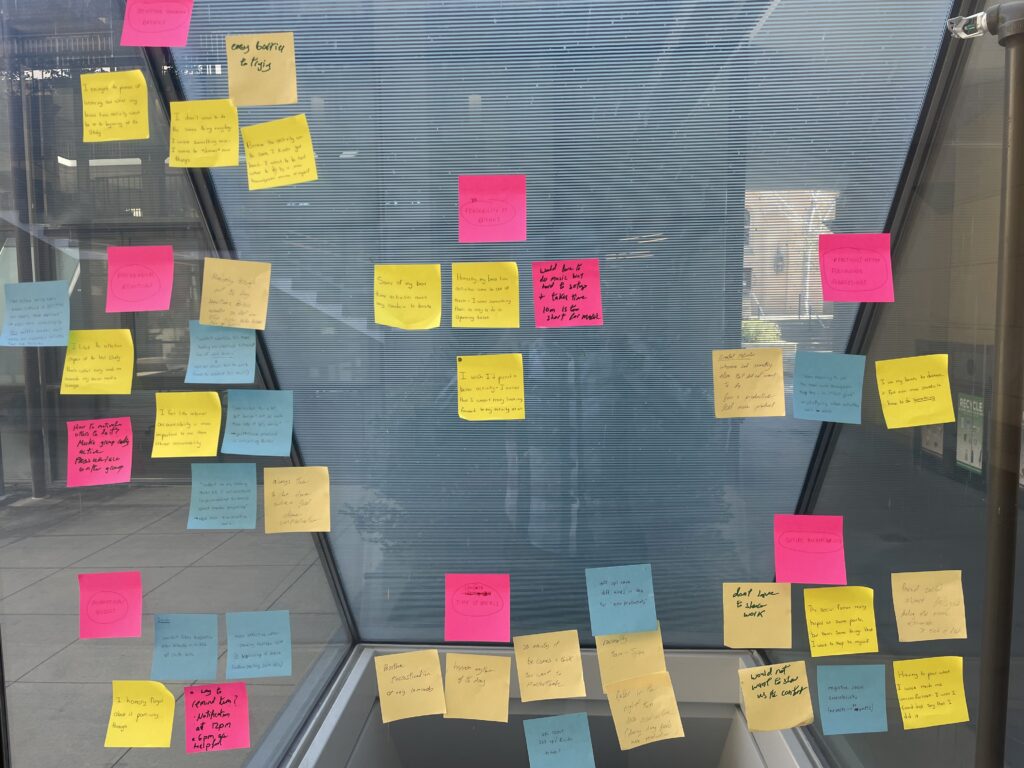Last time in our journey towards Meaningful Breaks, we introduced our problem and some preliminary research (Chapter 1), as well as our Baseline study (Chapter 2). Today, we’ll be taking a step forward towards putting some of our hypotheses to the test with Chapter 3 – The Intervention.
Chapter 3 – The Intervention
🔬 Research Questions
Over the course of what we’ve learned so far – 2 methods, in particular, have stood out as ways to enable and enforce more meaningful breaks. If we had unlimited resources and unlimited time, we’d methodically isolate variables, and attempt to determine just how effective each method is. But, we don’t! So here are the two research questions we’ll seek to answer over this intervention.
Question 1 – Lowering Activation Energy: Will offering people a tailor-made list of alternative break time activities reduces the urge to use social media during their breaks?
Question 2 – Social Accountability: Will the social mechanism of a public group accountability mechanism encourage them to choose alternative break time activities over social media?
🗺️ Our Intervention Plan
We’ve designed an intervention that’ll hopefully answer both of these questions at once. The premise is simple – we, the researchers, do the work of coming up with alternative break time activities for the participant to do – lowering the activation energy. After a pre-interview where we learn about the participant’s goals and motivations, we give them a list of 3 mini activities (mini defined as <15 minutes) during their breaks. Over the next 5 days, the goal is to complete activities from this list during their breaks.
Additionally, we’ve designed a social accountability component to increase the motivation to complete the alternative break time activity. We put each participant in a group with the other participants of the study. Every day, we ask them to send just a quick picture of them completing the break time activity to the group chat. At the end of the day, we do a quick tally of who has and hasn’t posted to the group chat. Hopefully, as in the app examples of Duolingo and Forest, this participatory social accountability will provide that extra motivation when the participant is inevitably presented with the option to either go on social media or do a more regenerative break time activity.
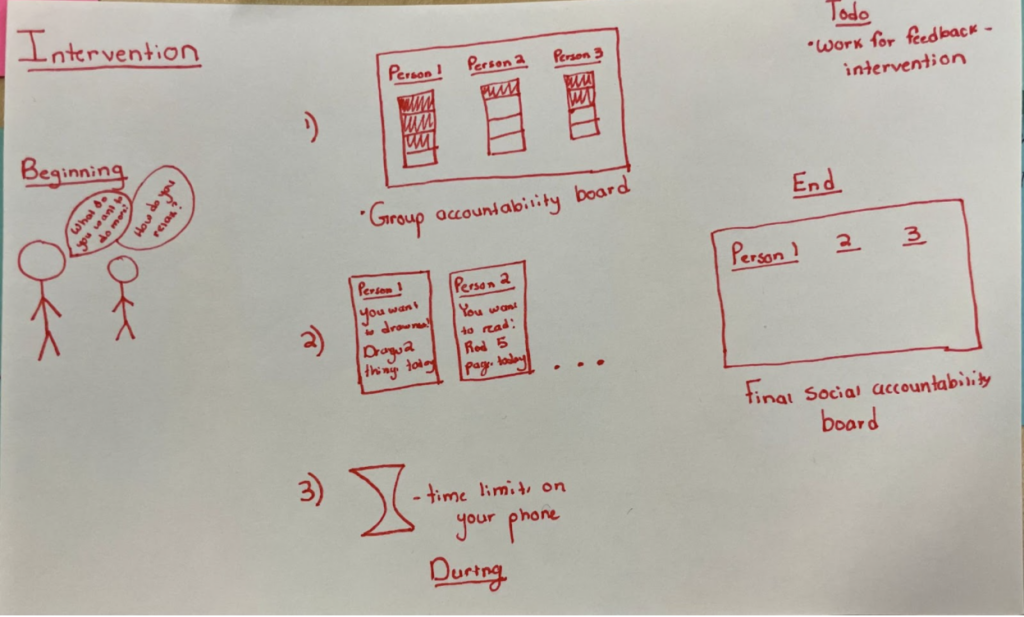
A Brief Sketch of our Intervention (Parts 1 and 2, not 3)
The Pre-interview
While we’ll ask a few more questions to investigate the participant’s goals, motivations and challenges, these two questions are the essence of what we’d like to learn.
Q1 – What is an activity (non-work related) that you would like to do everyday but are unable to?
Q2 – What is the smallest amount of time required to do a tiny bit of that activity?
The goal with these questions is to help us, the researchers, construct the list of “alternative break time activities” that we’ll send the participant. For example, if the participant answers “Write more” to question 1, and “Freewrite for 5 minutes” to question 2, we now have a better idea of what a tailor-made alternative break time activity for them might look like.
Intervention Format
Beginning of the Study: We brief the participants on their study, and give them their custom list of “alternative break time activities.” These will be in areas aligned with their interests, and will always take 15 minutes or less. We also add the participant to the study group chat (consisting of the researchers and other participants in the study).
Daily – The activities below will be done daily
Morning: We, the researchers, remind our users to take a picture of them doing an alternative break time activity during the day.
Early Evening: We ask our participant at a random time (after their scheduled activities are over) to post the picture of them doing the activity to the study group chat.
Night: We ask them how they feel about their progress with the activity, and expect just a quick response.
Post-Interview
While we’ll ask a few more questions to investigate the participant’s experiences, these two questions are the essence of what we’d like to learn.
Q1 – Was there a change in the amount of time/energy that you put into this activity before and during the study? Why do you think that might be?
Q2 – How did you pick which activity you’d spend during your break? What factors weighed into your decision?
Q3 – What was the experience of having social accountability partners? Did you find it encouraging, or more stressful?
Q4 – What did you think about the list of provided activities? Would you do them beyond the study?
Breaking it down
Data Collection
Luckily enough, our data collection methods were built into the study itself. Due to the social accountability provision, where we ask each participant to send a daily picture of them doing their break time activity, we have a nice log of when and what each participant did for their break. Aggregating this data, we constructed a table to observe how effective our study really was.
We then completed post-study interviews (the themes of the questions are outlined above) to really dig into why (or why not) the participants chose their break time activities, and how successful they were at completing them. We wrote the most memorable quotes down on post-it notes, and began to synthesize.
Synthesis
Distilling these down even further, we emerged with the following findings:
Key Findings
The What – Findings on the break time activities themselves
- People enjoyed thinking through a restful activity, but they felt limited by what they knew. One even pulled up the internet to search for restful activities
- Taking it a bit further, some wanted more spontaneity – “A new break time activity every day”; The “static nature” of the break just felt it was another thing to do
The Why – Why did people actually do these activities?
- Biggest surprise – One participant called the activities “Positive Procrastination”. They used the activity to put off work, but all while doing something that they enjoy.
The When
- Shorter 10-minute activities felt doable and refreshing whereas longer activities felt like tasks
- Nudges helped but would often come at unattainable times. 9 – 5 is they set aside workday
The How
- While the social accountability was overall positive, some people had activities that were too intimate to be shared through pictures.
And finally, The Who
- Midway through the study, some people don’t want to switch their break time activity at all.
Connection Circles
Throughout this, we begin to see some patterns emerge, but let’s visualize this on a connection circle to see it more clearly:
Connection Circle – Aggregate
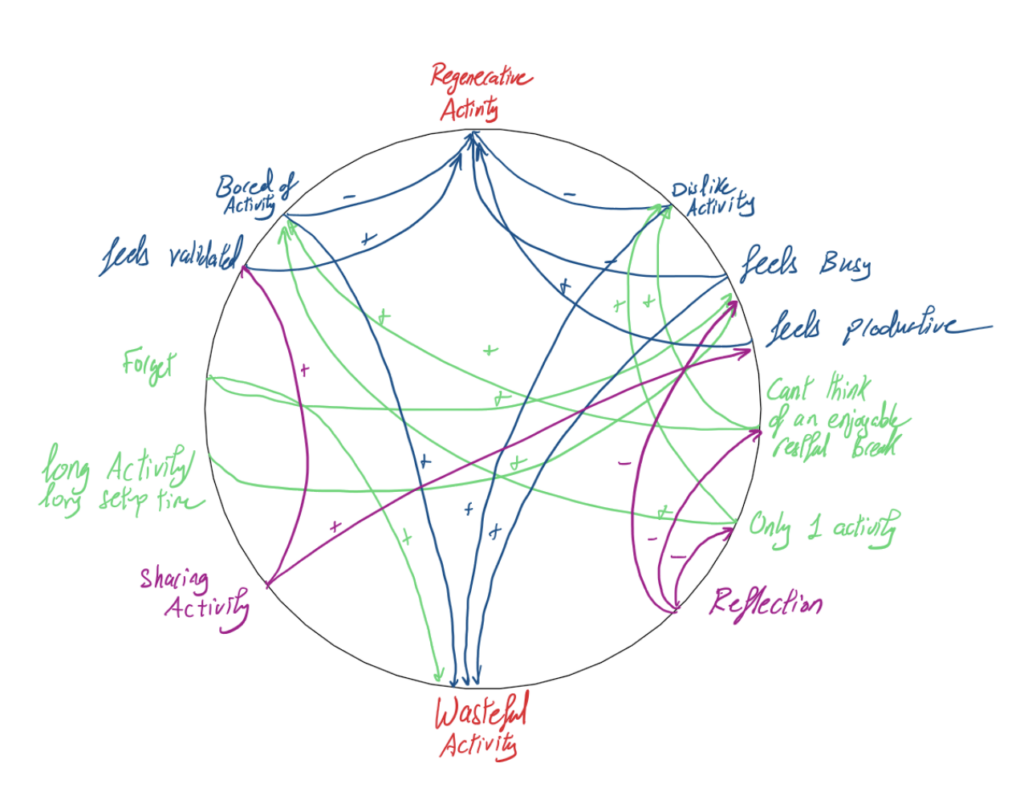
As you can see, there’s a lot going on here, and people’s motivations and challenges when deciding what to do on their breaks are very complex. Let’s break these down a little, and look at subsections of the above connection circle to really hone in on what’s going on.
Connection Circle – The Effects of a Bad “Break Substitute”
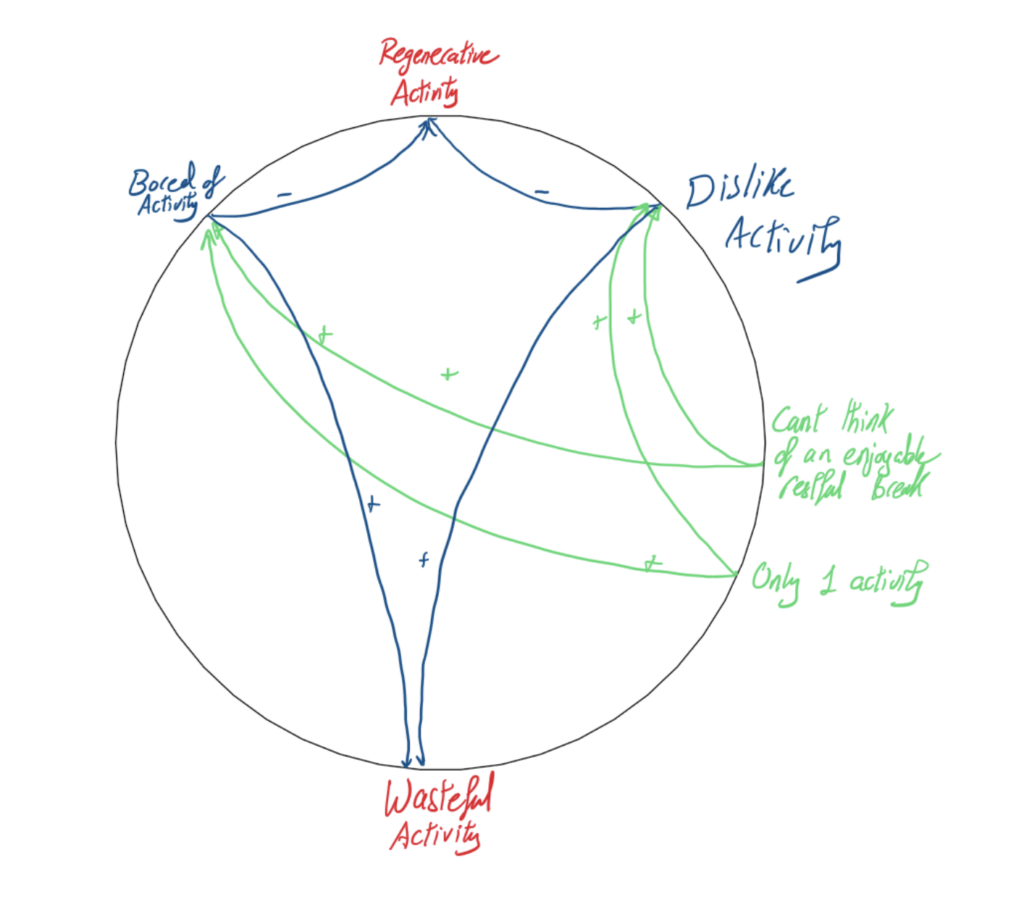
In this part of the connection circle, we can see the impacts of picking an activity that is not enjoyable for the participants (especially if only one activity is chosen). We see that if the activity is not enjoyable that they tend to get bored easily This is amplified by having limited or no options to choose from. This encourages the participants to spend their time on wasteful activities that give them instant gratification rather than the unenjoyable activity they picked.
Connection Circle – The Impacts of Social Accountability
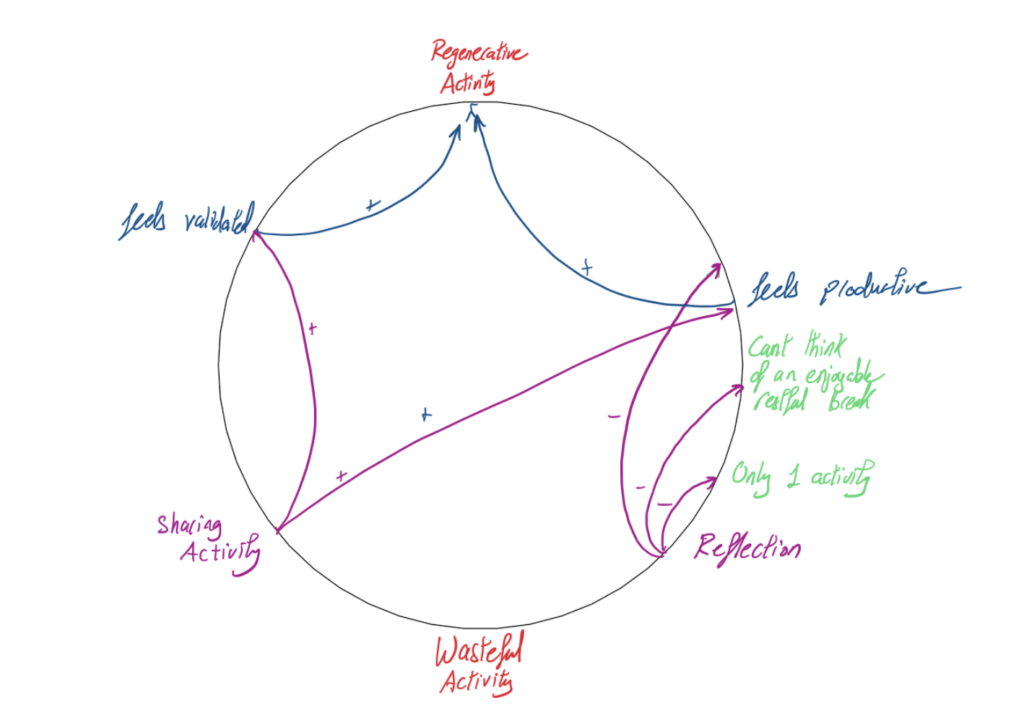
In this part of the connection circle, we can see the impacts of positive social accountability and reflection. As participants shared sharing their activities with their friends, they felt more validated as well as more productive. One participant said, “sharing the picture of my activity was so much more rewarding than ticking it off my todos”. As participants share more of their activities, they not only feel more productive but also feel validated by their social accountability group.
Moreover, we found that as people reflected on their behavior at the end of the day or at the end of the study, they felt more productive. They also became more introspective about the kind of activities that regenerated them as well as the activities that they falsely thought would be engaging for them to do during their break time.
Next Steps
So, what’s next? While the intervention study taught us a lot, there are still some unanswered questions before we design our final product. Namely, based on our very first key finding – what type of activities to people prefer to substitute social media with? Is it an activity they’d like to form a consistent habit around, or would they rather roll the dice, and be given an activity to do. Going back to our two by two, it appears the latter is closer to our original goal.
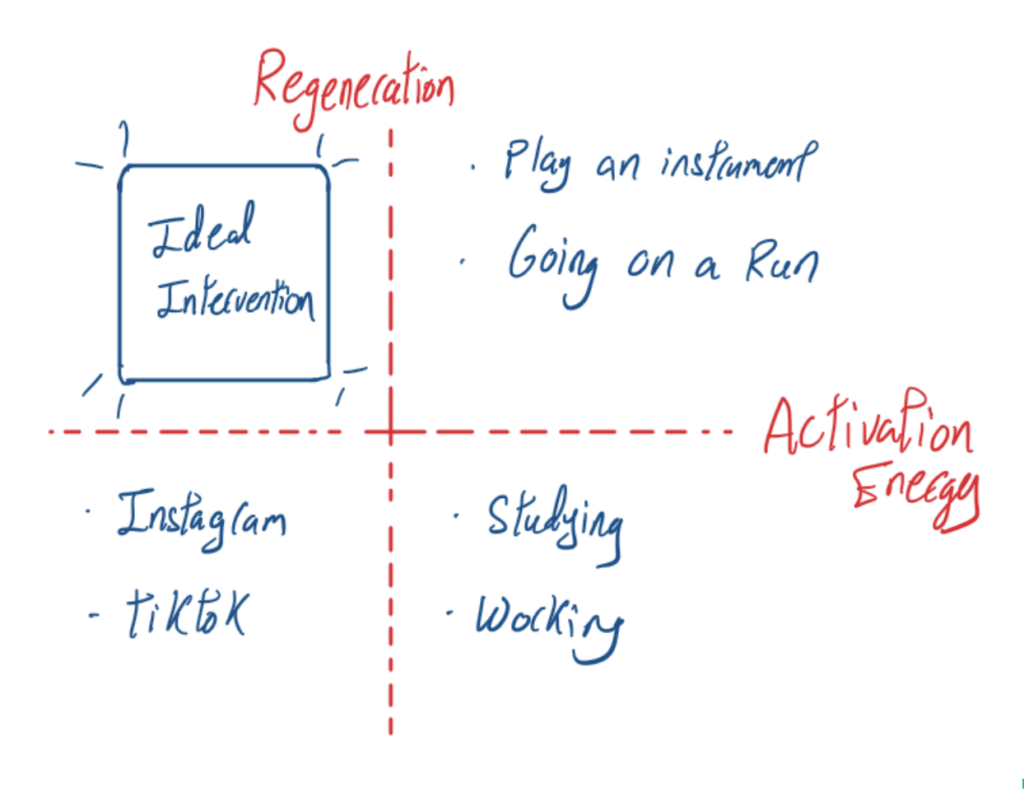
Many of the breaks that our participants did fit into that first quadrant – they have high regeneration and most participants feel great after doing them, but they also have high activation energy. There’s a lot of inertia that needs to be overcome to immediately go from finishing a PSET to instantly going on a run.
Going back to our original research questions – this means that while we were able to properly answer Question 2 (on the impact of Social Accountability), the jury is still out on Question 1. It seems as though our suggested break time activities were either not short or novel enough to truly be effective. So what’s next?
Chapter 3.5
We want to try an intervention with smaller activities (to test the impacts of low activation energy), that are randomized every day (address the concerns of this activity just becoming another habit the participant needs to juggle).
This will probably take the form of a mini-intervention that we conduct over the next few days as a way to build off of this one. The format will be similar to our first intervention study, with a few changes.
- It’ll be shorter – you know, for practical reasons
- The suggested break activities will be shorter. Based on our lit review, in our first intervention study, we suggested activities that were 20 – 30 minutes in estimated duration. This time, we’ll be aiming for activities that are closer to 10-15 minutes in duration.
- And finally, instead of coming up with a small list of activities beforehand, and having the participant complete those activites every day, we’ll switch it up. Instead, every morning, the participant will get their “Break time activity” of the day. They can then choose to do that one, or request another one.
And that’s the plan! We’d love some feedback, but otherwise, stay tuned for Chapter 4!

